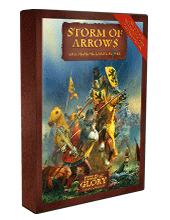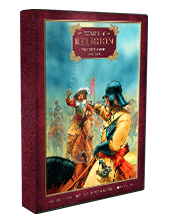Storm of Arrows
This army guide covers the armies of Western Europe from 1300 to 1500 AD.European warfare in this period was characterised by a rise in the role of infantry and a decline in the role of mounted knights. The Flemish, at Courtrai in 1302, showed that steady foot could defeat mounted knights. The Hundred Years War, between England and France from 1337 to 1453, raged through France and spilled over into the Low Counties and Spain. The English tactical system of massed longbowmen and dismounted men-at-arms deployed in defensive positions dominated the pitched battles of the war. The French knights were themselves forced to fight on foot to stand any chance, and even then they usually lost. Nevertheless, by avoiding pitched battles and concentrating on sieges, the French eventually won the war and expelled the English from the whole of France except Calais.
Meanwhile, the Swiss cantons were asserting their independence from feudal rule. Their massed infantry, initially halberdiers, later mostly pikemen, trounced the Austrian chivalry on several occasions, and later smashed Charles the Bold’s “perfect” Burgundian army. As the merits of the Swiss military system became apparent, pike formations were adopted in Germany and elsewhere, and became the dominant close fighting infantry type of the early Renaissance.
The term “men-at-arms” is used in these lists to include knights and other fully equipped men-at-arms and also less well equipped sergeants, valets, coustilliers etc. filling in rear ranks.
Equipment often varied widely in Medieval armies, even within a body of troops. Modern illustrations often show only the very best equipped men. We assume that many men, especially amongst the foot, were less well equipped. Accordingly, we have classified troops on the basis of their probable average level of equipment.
As far as possible, we have organised the army lists in geographical groups as follows:
100 Years War English (Continental)
100 Years War English (Britain)
Wars of the Roses English
Medieval Welsh
Later Medieval Scots (Britain)
Later Medieval Scots (Continental)
Later Scots Isles and Highlands
Later Anglo-Irish
Medieval Irish
Medieval French
Ordonnance French
Free Company
Navarrese
Later Low Countries
Medieval Burgundian
Ordonnance Burgundian
Swiss
Later Medieval German
Later Medieval Danish
Later Medieval Swedish
Condotta Italian
Medieval Crown of Aragon
Medieval Portugese
Medieval Castilian
Santa Hermandad Nueva Castilian
Later Granadine



 Cart (0)
Cart (0)
